Landscapes
Throughout the history of the Adirondacks, artists commonly chose to focus on nature in its purest form. Even while people mapped and surveyed the area, some chose to make quick sketches or paintings of what they saw. The Adirondacks were originally seen as a place of harsh wilderness, and this was reflected in the early artwork of the region. However, as time passed, humans attempted to conquer the land through exploitation and development, and they started to see the Adirondacks as a place of opportunity and economic potential. Once this shift occurred, humans and man-made structures began to appear in the artwork. Several pieces in particular demonstrate this transition from landscape paintings focused purely on nature to landscape paintings that reveal evidence of human influence.
Works of Pure Nature
Early paintings and photographs of the Adirondacks captured landscapes and wildlife with very little human influence. Before the Adirondacks were explored, they were portrayed as mysterious and ominous wilderness. As more information about the area became known, artists were able to explore different parts of the park and they began to romanticize nature.
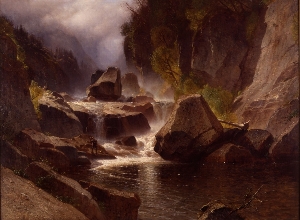
In Samuel Colman’s Untitled: Ausable River (1869, right), a waterfall cascades down large boulders lined by cliffs on both sides, and there is a mist thatalmost covers the mountains in the background. There is also a small man amongst the rocks, but he is dwarfed by the wilderness surrounding him (“Untitled: Ausable River”). This painting is fairly harsh and threatening, and the color palette is predominantly dark brown, green, and black. The use of spacing—enormous, jagged boulders dominate the line of sight, drawing attention to them—and the coloring make the image appear exotic. The fog gives the piece a mystical feeling, and the Adirondacks are accurately represented as wild land. While there is a man in the photo, he is in no way the focus of the painting. In fact, it is difficult to notice him without studying the image. In this particular instance, man had not yet conquered nature, and the wilderness is still a place of untamed beauty.
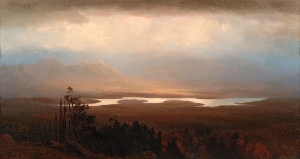
Works with Evidence of Human Influence
Even though modern works of art still show scenes of pure nature, it is common to see evidence of human impact and human activity in art today. For example, human impact can be seen through the construction of buildings, the destruction of trees, abandoned mining operations, the creation of hiking trails, litter and pollution, etc. Recreational activities often appear in Adirondack art as well, and while the focus of the piece remains on the landscape or wildlife, human activity is there to play a more minor role. As people conquered and developed the land, artwork reflected the idea that nature was there for humans.
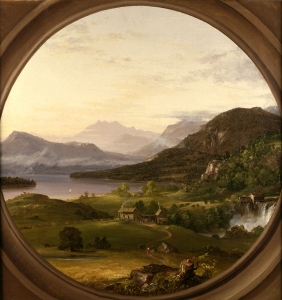
Thomas Cole’s Schroon Lake (1846, right) is a painting that examines the relationship between humans and nature. A log cabin sits in the center of the piece, and there is a tree stump in the foreground with rugged mountains in the background (“Schroon Lake”). The cabin and stump represent humans taming the wilderness, while the mountains and luminous sky represent the enchanting, untamed wilderness. The development of land clearly indicates human activity, and the tree stump shows the impact of humans on the land. This represents the opinion that people have the right to their own personal part of nature. While some residents do respect the land, others believe they can alter it to fit their needs, which takes advantage of something that cannot fight back and unfairly disrupts the ecosystem.
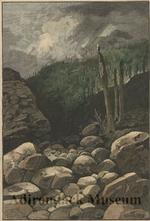
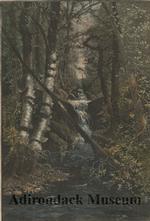
Works Cited
“A Feeder of the Hudson – As It Is.” The Adirondack Museum. The Adirondack Museum, n.d. Web. 1 April 2015.
“A Feeder of the Hudson – As It Was.” The Adirondack Museum. The Adirondack Museum, n.d. Web. 1 April 2015.
“Mountain View on the Saranac.” The Adirondack Museum. The Adirondack Museum, n.d. Web. 1 April 2015.
“Schroon Lake.” The Adirondack Museum. The Adirondack Museum, n.d. Web. 1 April 2015.
“Untitled: Ausable River.” The Adirondack Museum. The Adirondack Museum, n.d. Web. 1 April 2015.
Image Sources (in order of appearance)
Banner courtesy of: Amanda Lodge (original photo)
Untitled: Ausable River courtesy of: http://www.adkmuseum.org/discover_and_learn/collections_highlights/detail/?q=&cat=6&id=36
Mountain View on the Saranac courtesy of: http://www.adkmuseum.org/discover_and_learn/collections_highlights/detail/?q=&id=15
Schroon Lake courtesy of: http://www.adkmuseum.org/discover_and_learn/collections_highlights/detail/?q=&cat=3&id=22
"A Feeder of the Hudson – As It Was" courtesy of: http://adirondack.pastperfect-online.com/31694cgi/mweb.exe?request=record&id=C990167D-3E9A-4ECE-AB99-168335375990&type=101
"A Feeder of the Hudson – As It Is" courtesy of: http://adirondack.pastperfect-online.com/31694cgi/mweb.exe?request=record&id=C990167D-3E9A-4ECE-AB99-168335375990&type=101
